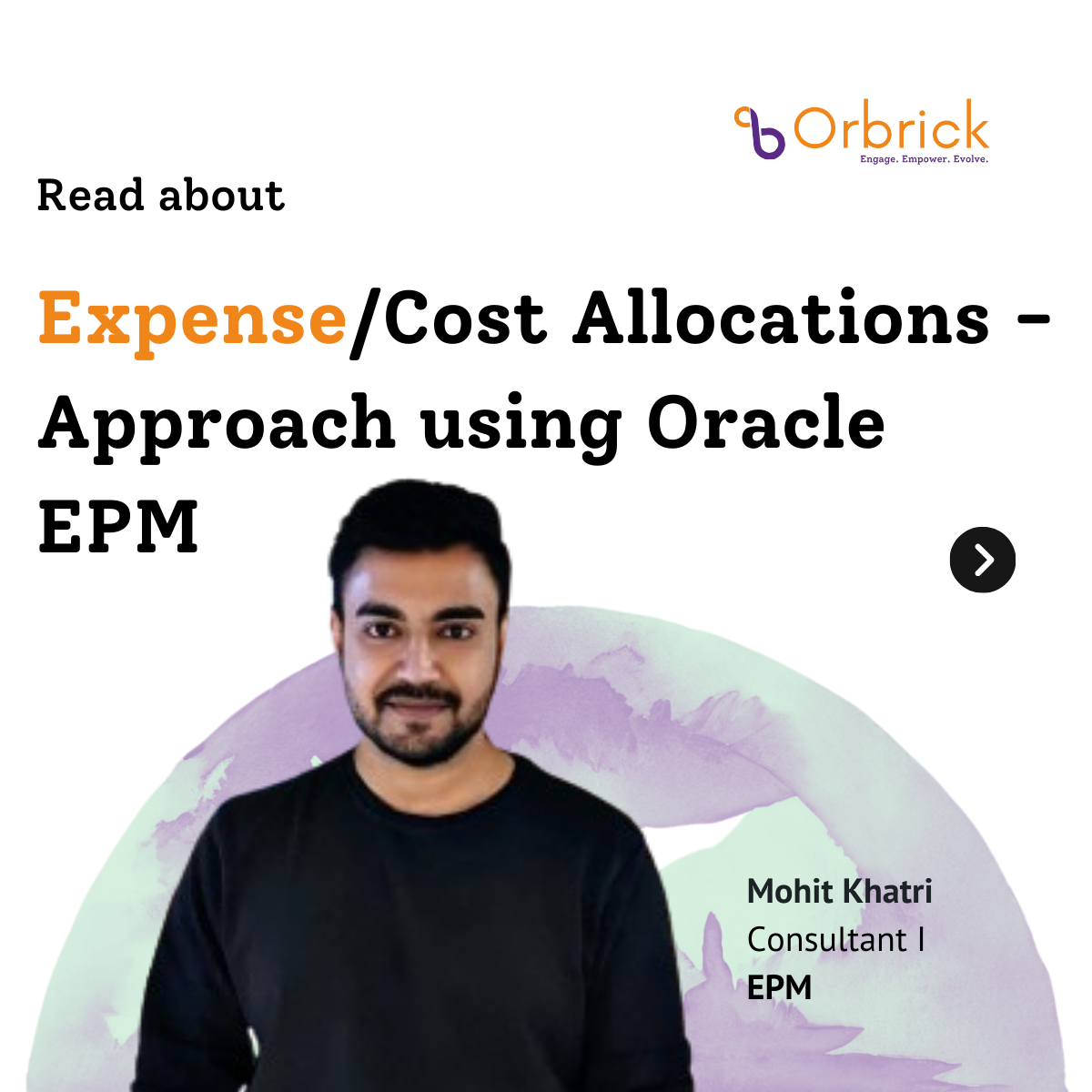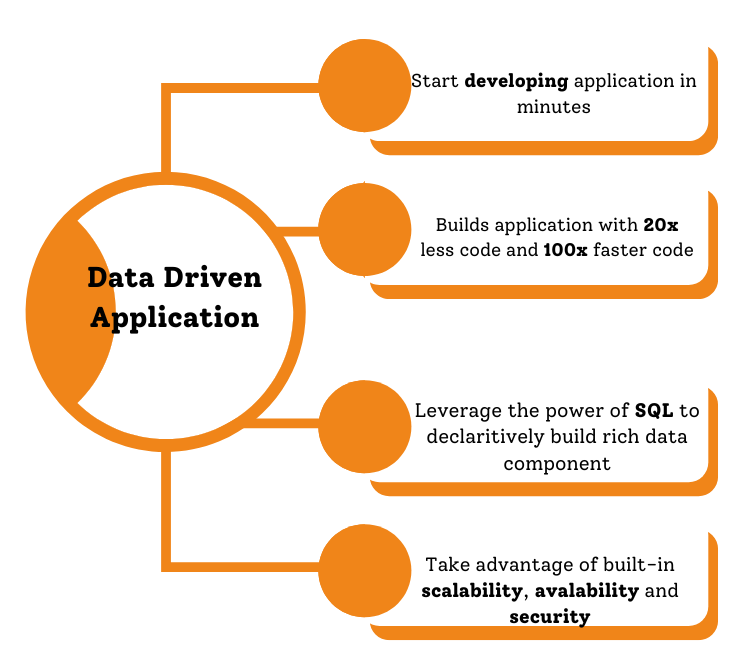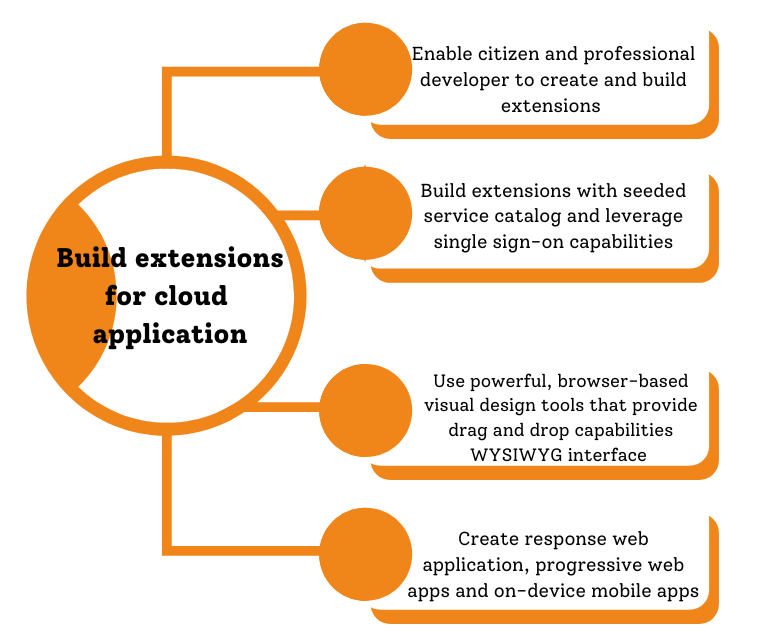Introduction
Evidently every organization, whether small or large, performs various financial and non-financial activities throughout its existence. These activities range from focusing on daily business activities, recording financial transactions, maintaining an efficient supply chain, managing human and other resources, to generating revenue to cover various expenses.
As the organization expands, complexities in all the business areas increase hand in hand. As a result, to let people focus on dedicated areas, responsibilities are delegated to various responsibility centers such as cost centers, revenue centers, profit centers, etc.
Responsibility Centers and the Expense / Cost Allocation
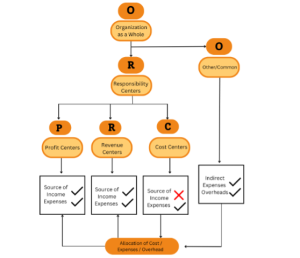
Both Revenue Centers and Profit Centers have their sources of income to meet their expenses. On the other hand, Cost Centers incur expenses related to their operation but do not directly generate income. Hence there should be some income source for the Cost Centers to meet their expenses and run their operations. In addition to that, there are various other indirect expenses as well as overheads at the organizational level that also need an income source to pay for. Here’s when the Expense / Cost Allocation comes into the picture.
The impact of expenses incurred by the Cost Centers (Finance Department, HR Department, IT Department, Admin Department, etc.) needs to be distributed across different departments of the organization. The objective is that all the departments are aware of and responsible for their share of costs, can efficiently use their resources and accurately perform financial planning.
Challenges in Allocating Expenses / Costs
As good as it may sound, more than 30% of organizations across the world face difficulty in allocating expenses to Revenue / Profit Centers because they perform this operation manually / traditionally. The difficulty in allocating the expenses manually / traditionally can vary based on several factors:
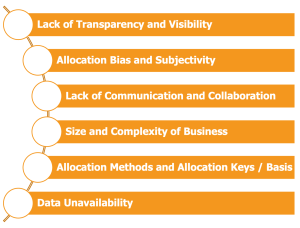
- Lack of Transparency and Visibility: In the allocation process, more than 50% organizations struggle in terms of transparency, which eventually leads to confusion and reduced efficiencies in tracking the way expenses are distributed across the cost centers.
- Allocation Bias and Subjectivity: There exists unfairness and inconsistencies in expense distribution because of non-standardized procedures as approximately 35% of organizations experience bias in their allocation process.
- Lack of Communication and Collaboration: For accuracy in cost allocation, effective communication and collaboration between Cost Centers and Finance Teams is crucial. Around 25% of organizations face difficulties in terms of effective communication and collaboration.
- Size and Complexity of Business: The larger the size of a business, the more will be its departments and products, resulting in a more complex cost structure. It makes manual allocation error prone and more time consuming. On average, 40% of the large-scale organizations have very complex cost structure and methods that they struggle with the manual allocation process.
- Allocation Methods and Allocation Keys / Basis: There exist multiple allocation methods and accordingly exist multiple allocation basis. Around 30% of organizations find it challenging to establish appropriate allocation methods as each method (Direct Method, Step / Sequential Method, and Reciprocal Method) has their own advantages and disadvantages. The simpler methods may be less challenging to manage, however, for more intricate ones, manual spreadsheet-based / traditional processes can become cumbersome.
- Data Unavailability: In manual spreadsheet-based / traditional processes, gathering accurate data from various sources with no data loss can become tedious and requires very much back and forth process. More than 30% of the Organizations face significant challenges with respect to limited data access or poor data quality.
Sources:
For Example:
In the Healthcare Industry, revenue streams are typically identified based on inpatient and outpatient days, categorized by the services provided by hospitals and clinics. The more services a hospital or clinic offers, the more complex and detailed the allocation process becomes.
Similarly, expenses in hospitals and clinics can be classified as direct, indirect, or overhead, depending on the cost centers and services provided to patients. For example, expenses like doctor fees, radiology test charges, or laboratory test charges can be directly allocated to the patient. However, allocating costs such as the salaries of ward attendants or supervisors to inpatients or outpatients requires a specific allocation method. Many other expenses cannot be directly assigned and require the use of drivers or activities to timely perform transparent and unbiased cost allocations with sufficient data being available.
Oracle EPM: Overcoming Manual / Traditional Challenges in Cost / Expense Allocation
Every organization has actual expenses that need to be allocated between the departments. It also has budgeted expenses that require allocation between the departments to perform efficient financial planning and forecasting.
To eliminate all the manual allocation challenges mentioned in the above section, you must have a robust software solution that automates the accurate data integration process as well as expense / cost allocation process using various allocation methods and allocation basis, for as big an organization as you have. Oracle Enterprise Performance Management (EPM) is the best fit for these requirements.
The modules of Oracle EPM help you perform the end-to-end process of allocating actual as well as budgeted expenses / costs in quick succession, in one click, and using simplest to most complex allocation methods and basis. Let me walk you through two of the best modules of Oracle EPM, i.e., Oracle EPBCS and Oracle EPCMCS, that best suits your needs.
Oracle EPBCS (Enterprise Planning and Budgeting Cloud Service)
- If an organization needs robust financial planning with options for direct or single-step allocation methods, both for actual and planned data, Oracle EPBCS is an ideal solution.
- In a SaaS deployment, Oracle EPBCS offers all the advanced budgeting, forecasting, data management, and analysis features of Oracle Hyperion Planning.
- It provides immediate value and boosts productivity for business planners, analysts, modelers, and decision-makers across every part of an enterprise.
- Oracle EPBCS supports organizations in various planning processes, including financial, workforce, capital, and project planning, along with what-if scenario analysis and modeling.
- These processes come with built-in best practices, including predefined content like forms, calculations, dashboards, drivers, and KPIs.
How can we eliminate challenges & meet the allocation requirements through Oracle EPBCS?
Oracle EPBCS can address the challenges of manual cost allocation in several ways:
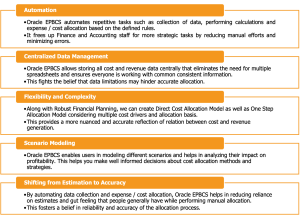
For Example: If a service industry or any other industry wants to allocate overhead costs like office rent or administration charges across their revenue centers, Oracle EPBCS can handle this efficiently. With actual and budgeted data already stored in the system, business rules, groovy scripts, and allocation driver logic can automatically distribute these costs across all revenue centers in a single step. If the budgeting or finance team wants to adjust the allocation pattern, they can easily select or create drivers based on their preferences, such as percentage allocation, gross margin percentage, revenue figures, or employee headcount.
Oracle EPCMCS (Enterprise Profitability and Cost Management Cloud Service)
- If an organization needs to perform direct, multi-step, or reciprocal allocation methods for both actual and planned data, Oracle EPCMCS is the perfect software choice.
- Businesses must be able to accurately measure, allocate, and manage costs and revenue to maximize profitability.
- Oracle EPCMCS helps manage the cost and revenue allocations needed to determine profitability across various business segments like products, customers, regions, and branches.
- It also allows you to use cost decomposition, consumption-based costing, and scenario analysis to measure profitability, providing valuable support for planning and decision-making.
How can we eliminate challenges & meet the allocation requirements through Oracle EPCMCS?
Oracle EPCMCS tackles manual cost allocation challenges in several ways:
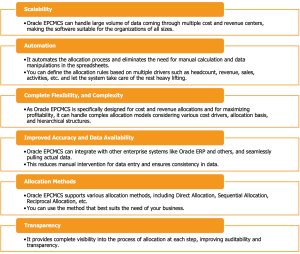
For example: If a Healthcare Industry wants to allocate its Direct Costs, Indirect Costs, as well as Overheads to its Revenue Centers, it must go through multiple allocation logics, drivers, and layers for the same. The more cost centers, expenses, and overheads involved, the more complex the allocation becomes. Suppose, the cost of surgical supplies might be directly allocated to the surgery department, while the maintenance department’s costs could be distributed first to other departments like radiology and surgery. Then, radiology’s costs might be further allocated to surgery and other departments. If the radiology department provides services to the laboratory, and the laboratory also serves radiology, a reciprocal method would allocate costs to reflect this mutual relationship. No matter how complex the allocation mechanism, Oracle EPCMCS is fully equipped to handle it using various drivers, logics, methods, and bases.
Conclusion
Overall, Oracle EPBCS as well as Oracle EPCMCS transforms cost allocation from a belief-driven manual process to one grounded in solid data and automation, helping you to take more informed decisions, improved cost control, etc. However, choosing one of the two or selecting both of them, is dependent on the business requirements.

- If the need is to perform robust Financial Planning as well as to perform Direct or Single Step Allocation, Oracle EPBCS can be chosen as it contains actual data through Data Integration, and the planned data is generated through the system itself.
- If the need is to focus on accurately measuring, allocating, and managing costs and revenue to maximize profitability, using Multi-Step Allocation or Reciprocal Allocation along with Direct Allocation, Oracle EPCMCS can be chosen as it contains actual data through Data Integration, and the Budgeted Data needs to be integrated from other planning systems like Oracle EPBCS.
